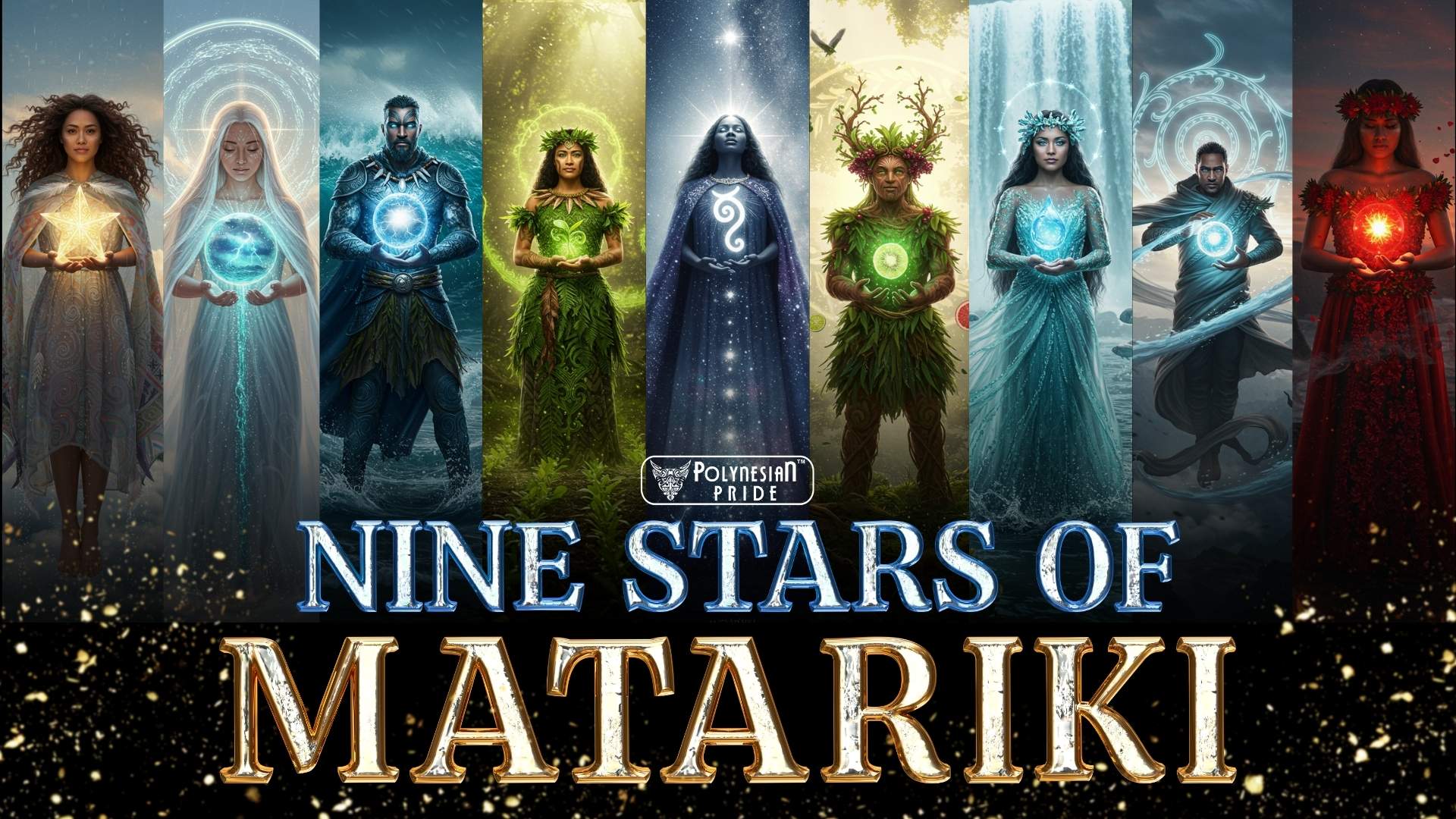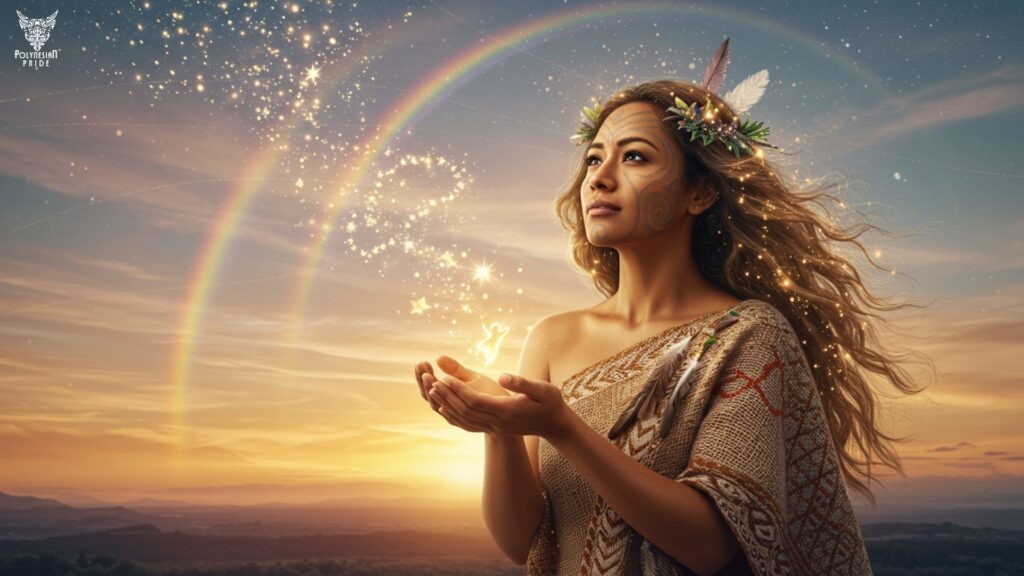Nine Stars of Matariki: Sacred Lights Guiding Māori New Year

When the winter skies of Aotearoa awaken with the rising of the Nine Stars of Matariki, a sacred celestial story unfolds – one that has guided Māori for generations. These stars are more than cosmic light; each one carries deep meaning connected to the land, the ocean, our ancestors, and our hopes for the future.
As the Māori New Year begins, the Nine Stars of Matariki invite us to reflect, remember, and reset. Whether you’re drawn to their spiritual meaning or just curious about their beauty, this journey will take you far beyond the stars.
What Is Matariki?
A Celestial Beacon of New Beginnings
Imagine waking before dawn, the world still wrapped in mist. You gaze at the northeastern sky and spot nine twinkling stars just above the horizon. These nine stars are Matariki, the Māori name for the Pleiades star cluster, a signal that the Māori New Year has arrived.
| Māori | Greek | Gender | Provenance |
| Matariki | Alcyone | Female | Well-being and health |
| Tupu-ā-rangi | Atlas | Male | Food that comes from above |
| Tupu-ā-nuku | Pleione | Female | Food that grows in the soil |
| Ururangi | Merope | Male | The winds |
| Waipuna-ā-rangi | Electra | Female | Rainwater |
| Hiwa-i-te-rangi | Celaeno | Female | Growth and prosperity |
| Waitī | Maia | Female | Fresh water |
| Waitā | Taygeta | Male | The ocean |
| Pōhutukawa | Sterope | Female | The deceased |
A Time to Reflect and Reconnect
Matariki is more than a stargazing moment, but it’s a profoundly spiritual event. It invites people to remember the past, celebrate the present, and plant intentions for the future.
For Māori, it’s a time to honor ancestors, gather with Whānau (family), and embrace new beginnings with gratitude and hope.

Meaning of Matariki stars
The name “Matariki” is often interpreted as either Mata Ariki (eyes of the gods) or Mata Riki (little eyes). Similar traditions exist across Polynesia, linking cultures from Hawai’i to the Cook Islands through this same ancient constellation.
From Ancient Tools to Modern Celebration
Historically, Matariki’s brightness was observed to predict the year; a clear and bright star meant abundance, while a dim and hazy one signaled hardship.
Today, it’s a public holiday and cultural revival that brings together storytelling, food, music, and Māori pride beneath the stars.

Why Nine Stars?
From Seven to Nine: A Cultural Evolution
For many years, Matariki was commonly thought to include seven stars, mirroring the widely known Pleiades constellation. But in recent times, Māori scholars and elders have re-emphasized the presence of nine distinct whetū (stars) in traditional knowledge. This discovery reflects not only astronomical observation but also the deeper spiritual and environmental connections within Māori cosmology.
Rediscovering the Full Whānau of Stars
The change from seven to nine isn’t just about numbers—it’s about reclaiming ancestral wisdom. Two stars, Pōhutukawa and Hiwa-i-te-rangi, were often overlooked in earlier colonial or Western records but have always had a place in oral traditions. Each of the nine stars has a unique role in representing parts of the natural world, from the oceans to the sky and even the afterlife.

Nine Guardians, Nine Gifts
Each star isn’t just a light in the sky—it’s a guardian, representing different domains of life. The expansion to nine allows for a fuller expression of the values, responsibilities, and relationships Māori people hold with the land (whenua), the waters (wai), and the cosmos (rangi).
Preserving Cultural Integrity
Restoring the complete nine-star narrative strengthens cultural identity and ensures future generations understand Matariki in all its richness. It’s not a correction—it’s a restoration of what has always been known by Māori communities, now brought back into the light for all to appreciate.

The Nine Stars of Matariki and Their Deep Meanings
Each of the Matariki stars names holds its own mana, linking to specific elements of nature and human experience – from rain and wind to dreams and memory. Here’s how each one shines in its special way:
1. Matariki: The Mother, Guardian of Well-being

- Role: Central star of the cluster and the mother of the eight other stars.
- Meaning: Symbol of health, vitality, and collective well-being.
- Location: The brightest star at the center of the Matariki cluster, visible just before dawn in late June.
Māori Cosmology Note: The name Matariki is thought to be short for Ngā mata o te ariki Tāwhirimātea, meaning “the eyes of the god Tāwhirimātea”, who tore out his own eyes and cast them to the heavens in mourning.
Rising first in the winter sky, Matariki is the nurturing heart of the cluster. Her appearance marks the Māori New Year and carries a message of care for our bodies, minds, and whānau. Traditionally, her brightness foretold the year ahead: glowing strongly meant abundance; dimness suggested a need for rest and resilience.
Today, Matariki reminds us to check in with ourselves. What does your well-being need—quiet mornings, reconnection, or a fresh routine? In looking to her light, we’re reminded that tending to our inner world is a sacred part of the new beginning.
2. Pōhutukawa: The Star of Remembrance

- Role: Guide for the spirits of those who have passed.
- Meaning: Represents memory, mourning, and the sacred link to ancestors.
- Location: A dimmer star on the outer edge of the Matariki cluster.
Māori Cosmology Note: Spirits are believed to travel along Te Ara Wairua, the spiritual pathway, to Te Rerenga Wairua, where they descend into the underworld from the ancient pōhutukawa tree on a cliff at the northernmost tip of Aotearoa.
Pōhutukawa is the star that calls us to pause and remember. She watches over the spirits of those who have passed, guiding them gently on their final journey. In Māori belief, when someone dies, their spirit travels to Te Rerenga Wairua (Cape Reinga) where it leaps into the afterlife from the roots of a sacred pōhutukawa tree clinging to the cliffs above the sea.
Her story is a powerful example of the Matariki star meaning by doesn’t just glimmer in the heavens, but it flickers in the memory of every loved one we’ve lost. Her appearance during Matariki is a gentle nudge to honor those who shaped us, to speak their names, and to hold space for their stories.
Whether it’s lighting a candle, preparing a favorite dish, or simply sitting quietly with their memory, Pōhutukawa invites us to grieve with love and reverence.
3. Tupuānuku: Earth’s Nourisher

- Role: Star associated with food grown from the earth.
- Meaning: Symbol of cultivation, nourishment, and our bond with the land.
- Location: Found toward the lower part of the Matariki cluster.
Māori Cosmology Note: The name Tupuānuku translates to “to grow in the earth”, reminding us of our deep dependence on the Whenua (land) for survival and strength.
As part of the Nine Stars of Matariki appear in the sky, Tupuānuku is the star that roots us, literally. She governs the food that grows from the ground: kūmara, potatoes, greens, herbs, and all the kai we plant, tend, and harvest with our hands in the soil.
For Māori, observing Tupuānuku helped determine when to end the previous season’s harvest and begin preparing for the next. A bright Tupuānuku signaled good conditions for planting, while a dim appearance suggested a need for caution or planning.
Today, her presence during Matariki is a gentle encouragement to reconnect with the whenua. Plant winter vegetables and tend your garden, even if it’s just a potted herb on the windowsill. Grow something you can share with your whānau and your neighbors or enjoy as a quiet act of care.
4. Tupuārangi: Feeder from the Forest and Sky

- Role: Star associated with food that comes from above – trees, birds, and forest foods.
- Meaning: Symbol of gratitude for gifts from the ngahere (forest) and sky.
- In the Sky: Positioned near Tupuānuku within the Matariki cluster.
Māori Cosmology Note: Tupuārangi means “to grow in the sky”, reminding us of our relationship with elevated spaces like treetops, flight, and the life that thrives above the ground.
Tupuārangi is the star that calls our eyes upward, to the trees, to the forest canopy, and the feathered life of the sky. His domain includes forest kai, such as fruits and nuts, and birds like kererū, which were once hunted during this season with great respect and ritual.
A bright Tupuārangi heralded a year of plentiful fruiting and successful foraging. For Māori, he represented the rich offerings of the bush—berries, ferns, blossoms, and birds—and underscored the importance of harmony with nature.
Today, Tupuārangi’s rising is an invitation to explore the ngahere with intention. It might be as simple as foraging citrus in your backyard, planting a native tree, or walking through a forest and offering a karakia. He teaches us to nourish others and share what we gather with our community.
5. Waitī: Flowing Freshwaters

- Role: Star connected to freshwater bodies and the life within them.
- Meaning: Represents rivers, lakes, springs, and the interconnected web of freshwater ecosystems.
- Location: Found near her twin star, Waitā, within the Matariki cluster.
Māori Cosmology Note: Waitī refers to the gentle, nourishing waters that run beneath and around us, and are essential for sustaining life in all forms.
Among the Nine Stars of Matariki, Waitī flows through like a river of light. She speaks to the mauri (life force) of all freshwater systems, from tumbling mountain streams to silent awa that cradle eels, trout, and the tiniest aquatic beings.
In traditional Māori life, observing Waitī offered clues about the health of rivers and lakes, and the abundance they would yield.
Today, this star reminds us of our duty as kaitiaki (guardians) of Aotearoa’s precious freshwater taonga. As Waitī rises, we are invited to respect and restore our waterways. This might mean joining a community stream clean-up, supporting freshwater conservation projects, or simply being mindful of how we use water at home.
Whether it’s the cup you drink, the rain that falls, or the mist that kisses your skin—Waitī reminds us that water is not a resource but a relative.
6. Waitā: Oceans and Sea Creatures

- Role: Star associated with the ocean and all life within it.
- Meaning: Represents saltwater ecosystems, tides, and kaimoana (seafood).
- Location: Sits closely beside his twin, Waitī, in the Matariki cluster.
Māori Cosmology Note: Waitā stems from wai (water) and tā (salt), linking directly to the expansive and powerful realm of Tangaroa, god of the sea.
Waitā is the voice of the sea. He rolls in with the tides, cradles the fish beneath the surface, and carries the salt-laced breath of the ocean to the shore. For Māori, her brightness during Matariki helped predict fishing fortunes, ocean moods, and the movement of tides for the year ahead.
H reminds us that the ocean is both a provider and protector and a taonga that has fed generations. In the past, rituals of gratitude and restraint were offered before gathering kai moana. Today, as oceans face the pressure of pollution and overharvesting, Waitā’s presence is a gentle but firm call to action.
During Matariki, honor him by making ocean-friendly choices: reduce plastic, support marine conservation, or gather seafood with care and respect. Even a barefoot walk by the sea can reconnect you to his mana.
7. Waipuna-ā-rangi: Bringer of Rain

- Role: Star associated with rainfall and replenishment.
- Meaning: Symbol of renewal, nourishment, and the life-giving power of rain.
- Location: Positioned on the outer arc of the Matariki cluster.
Māori Cosmology Note: Waipuna-ā-rangi means “the water that pools in the sky”, a poetic name for rainclouds and the blessings they bring.
As one of the Nine Stars of Matariki, Waipuna-ā-rangi is the weaver of rain, nourishing the land with every drop. In traditional times, her clarity during Matariki helped forecast rainfall and guided decisions about planting and preparation.
Today, she reminds us to value the water that sustains life. Her gentle presence is felt in every drizzle and downpour. Honor her by harvesting rainwater, planting with purpose, or simply stepping outside and feeling the rain on your skin.
8. Ururangi: Messenger of Winds

- Role: Star associated with wind and the movement of air.
- Meaning: Symbol of energy, transition, and unseen influence.
- Location: Found on the edge of the Matariki cluster.
Māori Cosmology Note: Ururangi means “winds of the sky”, used to forecast the nature of the coming year’s winds.
Ururangi carries the spirit of movement and momentum. His winds sweep through the landscape and our lives, stirring change. In traditional times, his presence during Matariki helped predict the year’s weather – wild gusts meant turbulence ahead; soft breezes suggested peace.
He reminds us that while we can’t control the wind, we can adjust our course. This Matariki honors Ururangi by letting go of rigidity and flowing with life’s shifts. A breezy morning, a deep breath, or flying a kite can all become small acts of connection.
9. Hiwa-i-te-rangi: Wisher of Dreams

- Role: Star of dreams, prosperity, and new beginnings.
- Meaning: Symbol of hope, personal aspirations, and the promise of abundance.
- Location: Often the smallest and final star to rise in the Matariki cluster.
Māori Cosmology Note: Hiwa-i-te-rangi is the star where Māori directed their wishes, but also where they placed their hopes for a successful harvest and future prosperity.a
Among the Nine Stars of Matariki, Hiwa-i-te-rangi shines as the star of promise. She listens to whispered dreams but also signals the hope for a fruitful season ahead. In traditional times, communities looked to her with expectation, not just for personal goals but for collective abundance: a strong harvest, full storage pits, and enough to feed all.
As Matariki rises, Hiwa asks us to think ahead with heart and purpose. What seeds – literal or metaphorical – will you plant this year? Will they feed your whānau, your creativity, your spirit? Now is the time to set your intentions with clarity and courage.
Honour Hiwa by writing down your goals, speaking them under the stars, or planting something in her name—let that act carry your wish into the year.
Together, They Weave the Year’s Tapestry
The Nine Stars of Matariki each carry their own story, but together, they form a map, a guide through grief and growth, nature and nurture, body and spirit. Whether you look at them with ancient reverence or modern curiosity, their wisdom lives on.
Matariki 2025 is coming! Explore our Matariki Collection at Polynesian Pride Shop and wear your heritage under the stars!
Continue Your Matariki Journey
Are you curious to experience more than just the stars? Explore how Matariki is celebrated across Aotearoa with feasts, music, storytelling, and community magic in our complete guide to the Matariki Festival 2025.
From hangi under the stars to fire-lit whaikōrero, discover the powerful ways this sacred time brings people together – heart, land, and sky aligned.

Wrapping It Up: The Stars That Guide Us
As the Nine Stars of Matariki rise in the winter sky, they do more than shimmer—they whisper. They speak of where we’ve been and where we might go. They call us to remember, to reconnect, and to dream.
Whether you’re watching the dawn with whānau, planting a seed of hope, or simply learning for the first time, Matariki invites you to stand still and look up—with heart, with heritage, with intention.
And when you’re ready to carry the spirit of the stars with you, explore our handcrafted Matariki Collection – a celebration you can wear every day.
Ka mua, ka muri—walking backward into the future with our eyes on the stars.
FAQs about Nine Stars of Matariki
What are the Nine Stars of Matariki?
The Nine Stars of Matariki are part of the u003cstrongu003eMatariki star cluster (Pleiades) in Māori astronomy. Each star represents a different aspect of life and the environment.
Why were there originally only seven stars in Matariki?
Earlier records, influenced by Western astronomy, recognized only seven stars. However, traditional Māori knowledge always included nine stars. Recent cultural revitalization has restored the complete nine-star narrative to honor all aspects of life that it represents.
When can I see the Nine Stars of Matariki in the sky?
From late May to early July, the Matariki cluster becomes visible in the northeastern sky just before dawn in New Zealand. The best viewing time is around late June when the stars rise during the Māori New Year.
What is the meaning behind each star in Matariki?
Each star has a specific domain: Matariki: Well-being; Pōhutukawa: Ancestors; Tupuānuku: Earth-grown food; Tupuārangi: Forest and sky food; Waitī: Freshwater; Waitā: Ocean; Waipuna-ā-rangi: Rain; Ururangi: Winds; Hiwa-i-te-rangi: Wishes and goals.
How is Matariki celebrated in New Zealand today?
Matariki is now a public holiday in New Zealand, celebrated with dawn ceremonies, feasts, remembrance rituals, cultural performances, and stargazing. It’s a time for communities to come together, honor the past, and set intentions for the future.

As an arts and traditional crafts specialist rooted in pe‘a (Samoan tatau), kapa making, and ceremonial carving, I’ve nearly 10 years of experience in fine art and its cultural significance. Experience the beauty of the traditional art of tattooing through my latest publication.
Inspire Your Style
Contact me:
Email: [email protected]
Tel: +685 77 23699










